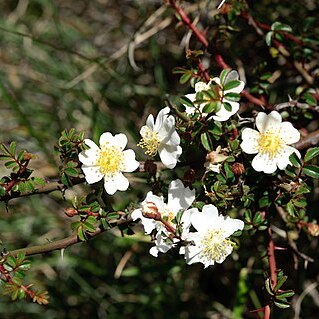Shrubs evergreen, dwarf. Branchlets glabrous; prickles sparse or in pairs below leaves, to 7 mm, flat. Stipules mostly adnate to petiole, free parts lanceolate, ca. 1 cm, both surfaces subglabrous or sparsely pubescent, margin filiform-dissected and glandular-pubescent; rachis and petiole pubescent, glandular-pubescent, sparsely prickly; leaflets 5–7, rarely 3, elliptic or oblong, 5–25 × 5–15 mm, abaxially puberulous along midvein, adaxially subglabrous, sometimes sparsely glandular-pubescent, margin acutely simply serrate, apex rounded-obtuse, acute, or truncate. Flowers solitary or 3–5 in cyme, 1.8–2.5 cm in diam.; pedicel ca. 1.5 cm, glandular-pubescent or not; bracts absent. Hypanthium subglobose to urceolate, glabrous. Sepals 5, triangular-ovate, abaxially pubescent and glandular-pubescent, adaxially tomentose, margin laciniate and glandular-pubescent, apex acuminate. Petals 5, white, obovate, ca. 10 × 5 mm, apex emarginate. Styles connate into column, subequaling stamens, villous. Hip subglobose, ca. 6 mm in diam.

